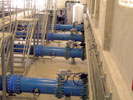Singapore's seawater desalination solution
May 2010
Analytical Instrumentation & Environmental Monitoring

Singapore began tackling its drinking water supply problem a few years ago. The first large seawater desalination system ‘TUAS Desalination’ was designed and built by Hyflux. The system operates according to the reverse osmosis principle and produces more than 136 000 cubic metres of drinking water per day – enough to fill about 55 Olympic size swimming pools.
Technology and process
Seawater desalination runs in several process steps. The first of these is the drawing of the seawater and feeding into the system. This is followed by a multistage filtration, flotation and ventilation to remove suspended matter and undesirable substances dissolved in the water. The filtered water is conditioned with ferric chloride, sulphuric acid, hydrochloric acid, caustic soda and other additives for reverse osmosis and set to a specific pH. Without these important water treatment steps, the downstream osmosis diaphragms would become useless very quickly.
After conditioning of the water, it is fed to the osmosis diaphragm modules by high-pressure pumps. The systems have a modular structure so that the diaphragms can be backwashed at regular intervals. In a system with 10 modules, for example, one of them is always in backwash mode whilst the others produce drinking water. In the last part of the system, after the reverse osmosis, which supplies almost distilled water, the water is brought back up to drinking water quality mineral content. This is the final process step before the water is fed into the distribution pipes and sent on its way to the consumers.
The GEMÜ solution
GEMÜ supplied more than 760 valves in nominal sizes from DN 15 - 1400 for this project. To offer the customers a package solution, valves were also purchased from partner companies. The customer could therefore be offered everything from a single source.
Butterfly valves with the different disc materials in 1.4408, bronze or ECTFE coated are mainly used in the seawater inlet, in the filtration/flotation and in the supply (tanks and pump stations). The nominal sizes are between DN 65 – 1400 and the operating pressure is 2,5–18 bar depending on the process area. Positioning is via pneumatic and electric solutions as well as manual operation using hand levers and gears.
In water pre- and post-treatment, highly chemically resistant diaphragm valves made of PVC or PVDF are used for the chemical dosing processes. The nominal sizes are DN 15 - 40, operating at pressures from 3-5 bar. Float flowmeters of nominal sizes DN 20 – 40 are also installed. Chemical dosing is fully automatic so the valves are usually controlled pneumatically.
The high pressure and non-return valves on the pump stations in front of the osmosis modules are made of special materials such as Super Duplex A890. They are controlled pneumatically and equipped with intelligent positioners. The differential pressure in the start-up phase of a pump is up to 60 bar. The operating pressure is usually between 5–84 bars the valves are designed in DN 300 throughout.
For more information contact Keith Hedges, GEMÜ Africa, +27 (0)11 462 7795, [email protected], www.gemue.de
Further reading:
DEKRA Industrial sets new standards for asset integrity in local petrochemical sector
Analytical Instrumentation & Environmental Monitoring
DEKRA Industrial South Africa has strengthened its position as a leader in hydrogen-induced cracking inspections through a strategic combination of advanced non-destructive testing techniques, investment in state-of-the-art inspection equipment and global technical collaboration.
Read more...
ABB leads in emissions monitoring with industry-first data acquisition system proficiency test
ABB South Africa
Analytical Instrumentation & Environmental Monitoring
ABB is the first company to offer a complete package of continuous gas analysis and DAHS systems fully compliant with international standards.
Read more...
Ensuring clean and safe water
Endress+Hauser South Africa
Editor's Choice Analytical Instrumentation & Environmental Monitoring
Endress+Hauser’s comprehensive range of disinfection sensors is designed to monitor and control disinfectant levels in water treatment processes.
Read more...
High-precision measurement of insulating gases
WIKA Instruments
Analytical Instrumentation & Environmental Monitoring
WIKA has launched the next generation of its GA11 gas analyser. It enables switchgear operators, manufacturers and maintenance companies to record the quality of SF6 gas and alternative insulating gases.
Read more...
Say goodbye to missed contamination with real-time colour monitoring
Analytical Instrumentation & Environmental Monitoring
Applied Analytics offers seamless and rapid colour monitoring in processes with an industry-proven analyser that quickly and accurately monitors colour in your sample stream for impurities and inconsistencies.
Read more...
Metrology laboratory is the heart of data-driven production consistency
Analytical Instrumentation & Environmental Monitoring
Pressing and welding have been at the core of Tier 1 automotive supplier, Malben Engineering for 50 years; but it is the company’s investment in its state-of-the-art metrology laboratory which has set it apart.
Read more...
Unlocking precision: The future of inline concentration measurement
Analytical Instrumentation & Environmental Monitoring
[Sponsored] In today’s resource-conscious industrial world, manufacturers are under growing pressure to optimise productivity, ensure consistent product quality and minimise waste. One of the most effective levers for achieving these goals lies in mastering concentration measurement, and Anton Paar is redefining how it is done.
Read more...
High-precision measurement of insulating gases
WIKA Instruments
Analytical Instrumentation & Environmental Monitoring
WIKA has launched the next generation of its GA11 gas analyser. It enables switchgear operators, manufacturers and maintenance companies to record the quality of SF6 gas and alternative insulating gases.
Read more...
Smart sensors for cleaner, safer food and beverage processes
Instek Control
Analytical Instrumentation & Environmental Monitoring
Instek Control specialises in advanced measurement solutions tailored for the food, beverage, pharmaceutical and mining industries. Among the company’s offerings are advanced process sensors from Anderson-Negele, as well as ALVIM biofilm monitoring technology.
Read more...
Elevating mining separation processes through precision instrumentation
Endress+Hauser South Africa
Analytical Instrumentation & Environmental Monitoring
In mining operations, the quest for efficiency and productivity is key. There is an urgent need for innovative solutions to enhance the performance of extraction processes while balancing operational costs and environmental impact.
Read more...


